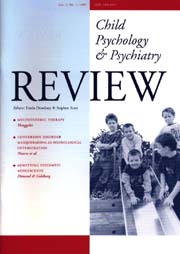No CrossRef data available.
Article contents
Abstract
Play offers children the opportunity to try out new ways of relating to the physical and social world. Through a range of encounters they can develop their imagination and skills, without incurring the material consequences of similar activities enacted ‘for real’. It is an essential and often joyful part of child development, and glum is the adult who does not retain some playfulness. It is a laboratory where children can develop different strategies to cope with the practical tasks of daily living and integrate themselves into a social network. Aberrant patterns of play may indicate a variety of difficulties and disorders in development, and may often provide important clues as to the problem. For example, a gross lack of imagination and rigid stereotyped play are found in children with autism; violent play with underdeveloped elaboration of emotional states is characteristic of children with conduct problems; repeated re-enactment of a single disturbing scene may be seen in children with post-traumatic stress disorder; and a disturbed pattern of emotional relationships is often exhibited in the doll play of children with attachment problems. As well as providing clues to the nature of a child's difficulties, play often offers an opportunity to engage with the child, and can provide a main avenue for therapeutic work, particularly with younger children who are not adept at talking about emotions and relationships.
In this and subsequent issues, we shall be publishing a number of commissioned reviews exploring children's play from a number of perspectives. Anthony Pellegrini and Peter Smith start us off with a review of the development of play and its forms and functions. As well as covering the structure of play including fantasy and pretend elements, the authors go on to consider its benefits for the child, and include a rather novel approach of attempting a cost-benefit analysis. Then Peter Blatchford reviews the state of play in schools. Here the importance of a time for the child to develop peer relationships and friendships away from the watchful gaze of adults is stressed, not only from a theoretical viewpoint, but from the practical standpoint of how much supervision should be given in the playground. In future numbers of the Review, we will publish an anthropological perspective by Allison James, a child psychotherapist's view by Anne Alvarez and Asha Phillips, and a review of the importance of drama in play and therapy by Peter Slade. At all times we would welcome your reactions, agreements, and disagreements, plus comments on what you think has been left out. Please do write to the Review office.
- Type
- Forum on Play
- Information
- Copyright
- © 1998 Association for Child Psychology and Psychiatry


